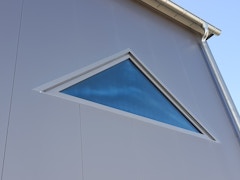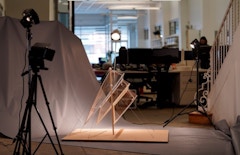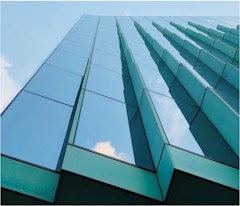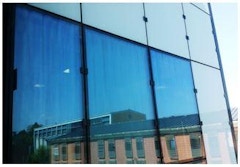
226 results
-
 The structural glass storefront facade at 111 Main Street in Salt Lake City lends itself as a case study in accommodating large building…
The structural glass storefront facade at 111 Main Street in Salt Lake City lends itself as a case study in accommodating large building… -
The Great Spandrel Glass Debate
- Paper by Richard Green SE PE P.Eng CPEng IntPE APEC Engineer M.ASCE M.IEAust, Principal / Owner
As we change the rules of thermal performance for facades, we are changing the conditions the glass is subject to in shadow boxes and glazed spandrel… -

Multifunctional Building Material Glass - A Colourful Bunch Of Requirements
- Paper by Michael Elstner · Steffen Schäfer
Glass as a building material plays a very important role in modern architecture, determines our visual landscape, and fulfills practical functions
-

Integration of Structural Glass in Historic Religious Buildings
- Article by Karine Charlebois, Associate
St. Patrick’s Cathedral’s Lady Chapel glass wall and the Trinity Church glazed canopy demonstrate that structural glass can be a great solution to improve the functionality of a historic building without competing with its original fabric.
-
Designing Structural Laminated Glass
- Paper by Vaughn Schauss
Laminated glass with standard PVB has long been used for safety and security due to its ability to adhere the broken glass fragments together. As the
-
HPDs for Facade Glass: How Transparent is Transparent?
"HPDs for Facade Glass: How Transparent is Transparent?" is an article published by the Advanced Technology Studio of Enclos examining chemical content reporting for glazed products.
-
Advances in Laminated Glass Engineering
- Paper by Richard Green PE (WA, NY, TX, CO, OR, MT), M.IEAUST CPEng, NER(Aus), APEC Engineer, IntPE(Aus), RBP(Vic)
The stability of monolithic glass fins is reasonably well defined; as an elastic material it behaves in a similar manner to other elastic materials
-

Realizing Bespoke Structural Glass Facades
- Paper by Ned Kirschbaum, FAIA, CCCA, LEED AP, kirschbaum@fentressarchitects.com Peter Koukos, Director of Strategic Process Alfonso Lopez, P.E., Principal and CEO
In the very earliest stages of a design, an architect imagines a unique glazed facade form and wonders, “Is this possible?” and “What will it cost?”… -

Anisotropic Effects in Architectural Glass
- Paper by Luis M. Hidalgo · Michael Elstner
Iridescence effects, quench marks, leopard marks… The names given to optical anisotropy in toughened and heat-strengthened glass are diverse and
-
Thermal Stress Analysis in Glass
- Paper by Michael Elstner, Director of Technical Advisory Service Michaela Poláková, TAS Engineer Steffen Schäfer,
The use of glass in windows and curtain walls in residential as well as in commercial buildings needs to be designed very carefully. In addition to… -
Corrugated-geometry Copper and Glass Facade
- Paper by Marko Tomsic, PE · John A. Jackson, AIA
The subject of this case study is the design and construction of a custom corrugated-geometry facade featuring pre-patinated copper and glass for an
-

Prototyping with Ultra-Thin Glass
- Paper by Sophie Pennetier · Josephine Stoddard · Karen Kensek
This paper proposes system concepts and fabrication methods for the use of ultra-thin glass in facades. It documents the team's research on
-
Structural Silicone Sealant and Glass Fins
- Paper by Jon Kimberlain · Valerie Hayez · Jie Feng
Structural silicone sealant is commonly used in glass fin applications, both as a weatherseal and as for structural attachment. A common concern for
-

Seismic Design of Jumbo Glass Structures
- Paper by Alfonso E. Lopez, P.E., CEO David Dunham, P.E., Director of Business Development
The design of structural glass systems continues to evolve with the parallel development of new manufacturing technology. Improvements in the… -

Feasibility of Measuring Stress in Glass with a SCALP
- Paper by Nabhajit Goswami · Stephen M Morse, P.E., Ph.D.
The SCALP device is designed to measure the residual compressive surface stress of glass. As the SCALP does not rely on the birefringence properties
-
The Scope of the Structural Glass Design Manual
- Paper by Richard Green SE PE P.Eng CPEng, Principal / Owner Andrew Crosby P.Eng LEED® AP BD+C, Principal Terrence McDonnell SE SECB PE P.Eng, Principal
The technology of glass now allows glass to be fabricated in sizes and structural configurations not previously conceivable. The standards and codes… -
Comparison of Historical Weathered Annealed Glass Failure Data to ASTM E1300
- Paper by Nabhajit Goswami; Student · Stephen M Morse; Assistant Professor, Civil and Environmental Engineering Assistant Professor, Mechanical Engineering-Engineering Mechanics Michigan Tech University
Historical published weathered annealed failure data consisting of 13 samples were collected and glass failure prediction model surface flaw
-
Controlling Anisotropy in Heat Treated Glass
- Paper by Francis Serruys · Dr. Romain Decourcelle
Anisotropy is also known as Brewster marks, quench marks, strain pattern, leopard spots, Iridescence, etc. Although anisotropy is inevitable when
-
Design of Facade and Overhead All-Glass Structures in Building Renovations
- Paper by Alfonso E. Lopez, P.E., Principal & CEO David Dunham, P.E., Director of Business Development Andrew Duncan, Pre-Construction Design Consultant
The contemporary renovation of historic buildings often includes all-glass structures that allow architects to preserve the original building design… -

Design of Double Curved Self Spanning Horizontal Laminated Glass
- Paper by Beres Dowdle, Director
There is a desire in architecture to design and achieve transparent canopies and glazed rooves that are free from the visual clutter and the…


